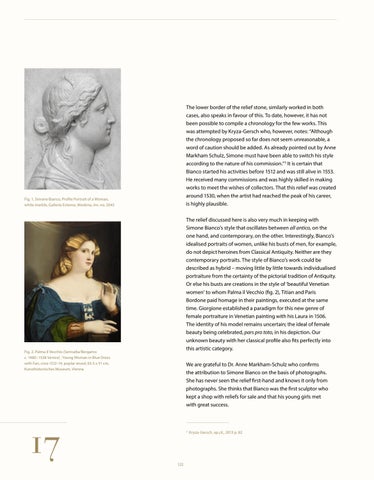The lower border of the relief stone, similarly worked in both cases, also speaks in favour of this. To date, however, it has not been possible to compile a chronology for the few works. This was attempted by Kryza-Gersch who, however, notes: “Although the chronology proposed so far does not seem unreasonable, a word of caution should be added. As already pointed out by Anne Markham Schulz, Simone must have been able to switch his style according to the nature of his commission.” 5 It is certain that Bianco started his activities before 1512 and was still alive in 1553. He received many commissions and was highly skilled in making works to meet the wishes of collectors. That this relief was created around 1530, when the artist had reached the peak of his career, is highly plausible.
Fig. 1. Simone Bianco, Profile Portrait of a Woman, white marble, Galleria Estense, Modena, inv. no. 2045
The relief discussed here is also very much in keeping with Simone Bianco’s style that oscillates between all antico, on the one hand, and contemporary, on the other. Interestingly, Bianco’s idealised portraits of women, unlike his busts of men, for example, do not depict heroines from Classical Antiquity. Neither are they contemporary portraits. The style of Bianco’s work could be described as hybrid – moving little by little towards individualised portraiture from the certainty of the pictorial tradition of Antiquity. Or else his busts are creations in the style of ‘beautiful Venetian women’ to whom Palma il Vecchio (fig. 2), Titian and Paris Bordone paid homage in their paintings, executed at the same time. Giorgione established a paradigm for this new genre of female portraiture in Venetian painting with his Laura in 1506. The identity of his model remains uncertain; the ideal of female beauty being celebrated, pars pro toto, in his depiction. Our unknown beauty with her classical profile also fits perfectly into this artistic category.
Fig. 2. Palma il Vecchio (Serinalta/Bergamo c. 1480 – 1528 Venice) , Young Woman in Blue Dress with Fan, circa 1512–14, poplar wood, 63.5 x 51 cm, Kunsthistorisches Museum, Vienna
17
We are grateful to Dr. Anne Markham-Schulz who confirms the attribution to Simone Bianco on the basis of photographs. She has never seen the relief first-hand and knows it only from photographs. She thinks that Bianco was the first sculptor who kept a shop with reliefs for sale and that his young girls met with great success.
5
122
Kryza-Gersch, op.cit., 2013 p. 82

























